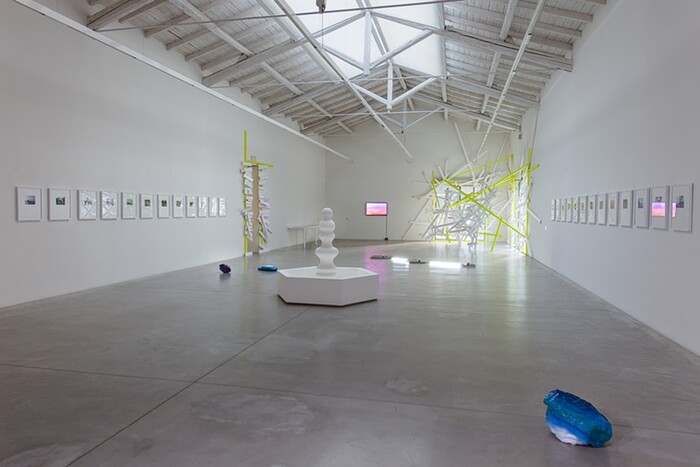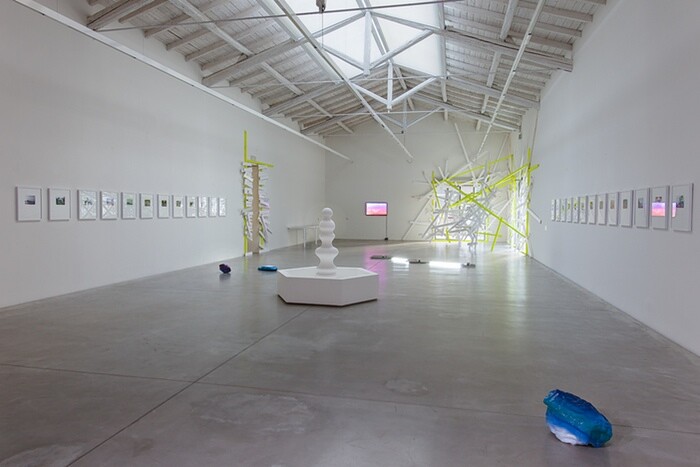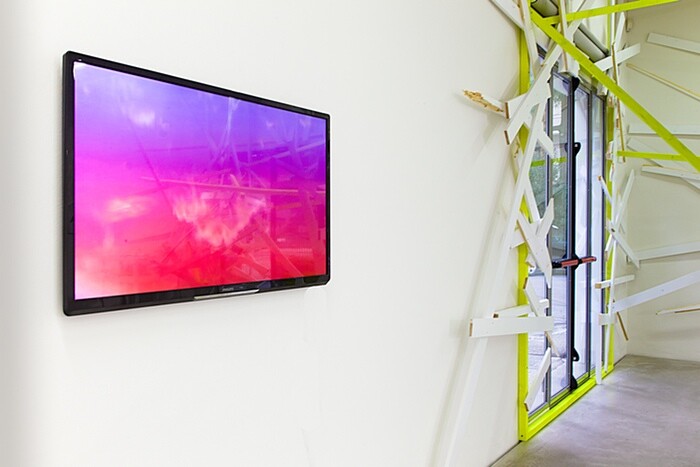A barren desert, a swarm of apparitions: the Italian writer Dino Buzzati’s novel, The Tartar Steppe (1940), is one of the few in Italian literature in which the idea of a hallucination, or fata morgana, becomes a narrative mechanism with allegorical power, peopled by characters worn down by endless waiting, in an infinite state of solitude. “The enigmatic patch of darkness seemed to be motionless,” he writes, “and little by little Drogo began to think again that there really was nothing there, only a black boulder like a nun, and that his eyes had been deceived—a touch of fatigue, that was all, a silly hallucination.”
“Fatamorgana” is an exhibition in which, so to speak, the fantasy of the Tartar wilderness takes on substance. Basking in a vast phantasmagoria of withered dreams and dashed expectations, the presentation springs from a desire to decipher the boundaries of the desert of reality through which we move. The works chosen by the curator—Antonia Alampi, currently based in Cairo—act on all five senses, but at the same time, they subtly stimulate our sixth. The entrance of the gallery, wrapped in a spiderweb of brightly colored planks looks like a jumble of scaffolding in the grip of nervous exhaustion, serving only to disorient the eye. This, an ephemeral site-specific sculpture by Clemens Hollerer titled No Shelter (2014), encapsulates a world that has strayed off course. Through it, there is only the thinnest opening between the rough boards to glimpse the almost invisible work by Goda Budvytyte which sits behind it. One must squint to see it, as if searching for a speck of gold in the sand. Stuck to a square of glass are the adhesive vinyl outlines of a wave and a mountain, and though one cannot immediately make it out, the monogram “FM” appears within the gentle undulation of the interwoven lines, a subtle allusion to the exhibition’s title.
Sewn into the concrete fabric of the mirage, a video by Malak Helmy titled Records from the Excited State – Chapter 3: Lost Referents of Some Attraction (2012) is a chain of unreal, adulterated visions as sticky-sweet and artificial as a cascade of colored M&Ms: beaches sparkle like mica powder; skies blaze magenta; salt flats trace mysterious figures and syrupy purple, turquoise, and emerald hues pour out over the polished surface of three large fiberglass stones (Scene 4: A composition for gradients, 2014). Also by Helmy is Marble marble fountain gurgle fountain marble marble (2014), a fanciful white polyurethane version of the classic fountain found decorating Middle Eastern housing complexes and shopping centers, and which, deprived of its foam and spray, seems to float at the center of the exhibition space.
Nearby, Basim Magdy has lined the longer walls of the gallery with 25 color prints (Every Subtle Gesture, 2013) that depict motionless scenes where time seems to flow as sluggishly as honey. Waterfalls, stuffed birds, flowering or festooned branches: it unravels as an imagined slideshow held together by the loose fragments of a script that has chosen to forgo plot, characters, and structure. In a similar way, Screenplay for Amsterdam (2012-2013) by Carlos Amorales conjures up a mood without the aid of a narrative arc. Composed only of photocopied images, hazy as ghosts, its story seems reluctant to reveal itself. Keyed to the same pitch—that of a secretive whisper—Amorales’s second work in the exhibition, El Buro Fantasma (The Ghost Bureau, 2014), presents the printing plates for seven pages of a Mexican newspaper. This collection of ordinary Monday-morning articles is turned into a surreal collage by the presence of bizarre little items about the relationship between art, poetry, and Chilean political history, which the artist has stealthily inserted in the publication.
Prisoners of their own illusion and enveloped by a bluish mist that never lifts from the gallery, these unique and quivering works collectively seem to gesture to the existence of an external world. They provide a real-world magnetism, summoning strange apparitions. Magic, on the other hand, is the element that leavens Trinity Platform [Coordinates – Giza complex + Orion Constellation] (2014) by Luca Pozzi, which gravitates around three black platforms, neon lights and electromagnetic fields. Looking at it, one is overcome by a sense of fatalism, as if contemplating an abyss. Around the platforms electromagnetic fields allow several luminescent sponges to levitate, their collective form referring to the pyramids of Giza, whose placement is an earthly echo of the Orion constellation. The piece tells a weightless story amid the cogs and wheels of the dark celestial sphere holding it up. The sponges smoothly revolve, the hours wear on, and the desert glitters—lonelier than ever.
“Fatamorgana” is an exhibition of artworks that speaks to certain aspects of our present, characterized by a crisis of imagination, concerned with the past and the expectations—melancholic, hopeful—of the future. The mirages and the magic invite us to wonder about how power—political power, but not only—increasingly resides in our ability to build and recognize the illusions that surround us.










